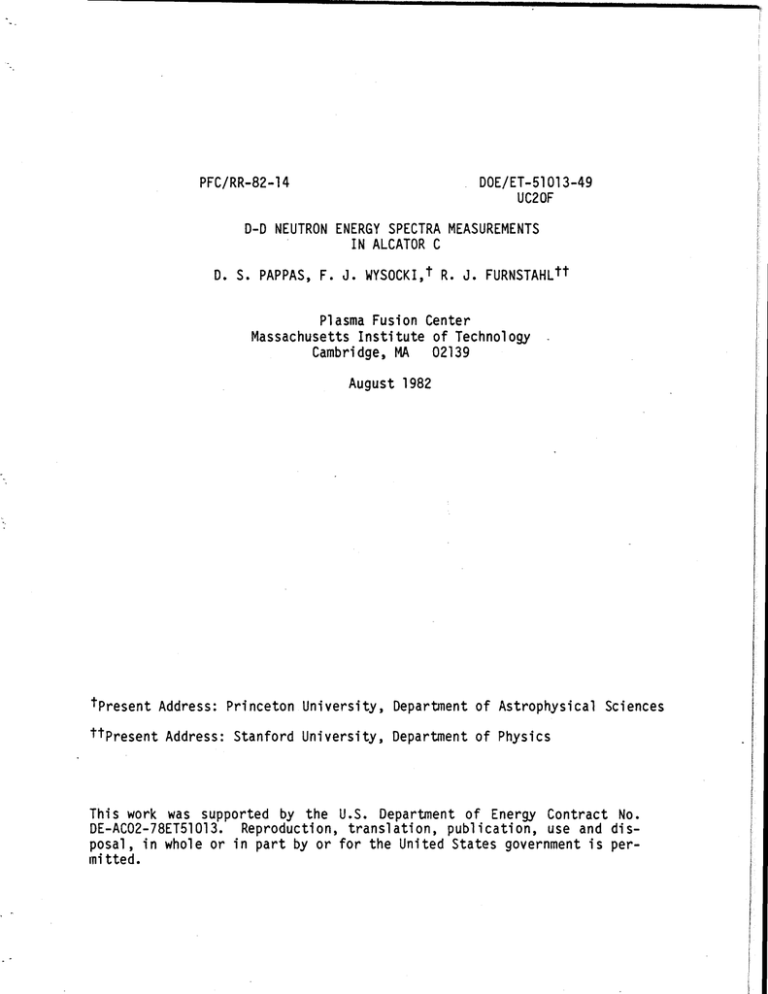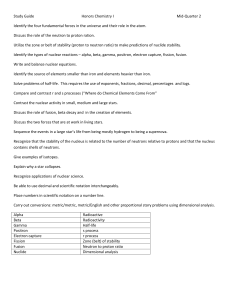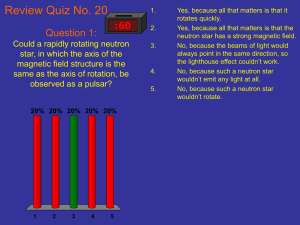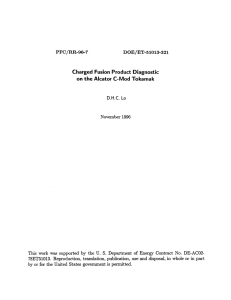PFC/RR-82-14 C Plasma Fusion Center Massachusetts Institute of Technology
advertisement

PFC/RR-82-14
DOE/ET-51013-49
UC20F
D-D NEUTRON ENERGY SPECTRA MEASUREMENTS
IN ALCATOR C
D. S. PAPPAS, F. J. WYSOCKI,t R. J. FURNSTAHLtt
Plasma Fusion Center
Massachusetts Institute of Technology
Cambridge, MA
02139
-
August 1982
tPresent Address: Princeton University, Department of Astrophysical Sciences
ttPresent Address: Stanford University, Department of Physics
This work was supported by the U.S. Department of Energy Contract No.
DE-AC02-78ET51013. Reproduction, translation, publication, use and disposal, in whole or in part by or for the United States government is permitted.
D-D NEUTRON ENERGY SPECTRA MEASUREMENTS
IN ALCATOR C
D. S. Pappas, F. J. Wysocki, R. J. Furnstahl
Plasma Fusion Center
Massachusetts Institute of Technology
Cambridge, Massachusetts
02139
USA
ABSTRACT
Measurement of energy spectra of neutrons produced during high density
(ne > 2 X 1014 cm- 3 ) deuterium discharges have been obtainedl using a
proton-recoil (NE
213) spectrometer.
A two foot section of light pipe
(coupling the scintillator and photomultiplier) was used to extend the
scintillator into a
diagnostic
detection efficiency
while
requirements.
energy spectra.
not
viewing
port to maximize the
imposing excessive magnetic
neutron
shielding
A derivative unfolding technique was used to deduce the
The results showed a well defined peak at 2.5 MeV which
was consistent with earlier neutron flux measurements on Alcator C that
indicated the neutrons were of thermonuclear origin 2 .
INTRODUCTION
Regimes of operation in present day fusion devices result in copious
These fusion neutrons which emanate from the
production of fast neutrons.
hot plasma core can not only give direct evidence of plasma having thermonuclear parameters, but also may allow determination of central ion temperatures a feature of prime importance in high density tokamaks such as
the Alcator devices 3 .
Under certain circumstances tokamak operation can lead to non-thermonuclear neutron emissions that can exceed expected thermonuclear rates 4 ,5,6,
thus the origins of the neutron emissions must be determined.
Measurement of neutron energy spectra can provide information concerning neutron origins as well as information on plasma properties.
The re-
sults described here were the first neutron spectra measurements from
Alcator C and
were obtained
deuterium into the device.
hydrogen fill
shortly after the first introduction of
Alcator C had commenced tokamak operation in
for the first six months, at which time photonuclear neutron
rates were routinely reduced to less than 106 n/sec 6 . Since the expected thermonuclear yields were to be approximately 1010 n/sec during the
initial D-D operation,
the spectrometer used for these experiments was
chosen for its high efficiency rather than for maximum energy resolution.
Specifically, the spectrometer consisted of a 5 cm X 5 cm NE 213 liquid
organic 7 ,8,
3
scintillator
optically coupled to an
RCA 8850 photomul-
tiplier tube using a two-foot section of cast acrylic lucite plexiglass
rod.
The location of the spectrometer in relation to Alcator C is shown in
Fig. 1. Standard Ortec circuitry (Fig. 2) was used for
- 2 -
n-y pulse shape
of neutron only pulses
discrimination to allow pulse height analysis
during the experiments.
RESULTS
Shown in Fig. 3 is a nominal spectrum ('D(E)vs.
flux at energy E in neutrons/cm2-sec,
1 keV D-D maxwellian plasma.
E where P(E) = neutron
and E = neutron energy in MeV) for a
The velocity distribution of the reacting
deuterons gives rise to a doppler broadening of the spectral peak.
The
energy spectra for maxwellian velocity distributions has been calculated
by Faust and Harris 9 .
For a maxwellian deuterium plasma the width can
be written as FWHM = 83.25 (KT)
1/ 2
keV, with KT in keV.
The resolution
of the high efficiency spectrometer used in this work was 20% or about
The efficiency of the detector however was approxi-
500 keV at 2.45 MeV.
mately 104 times the efficiencies of the usual (He3, Li sandwich, etc.)
high resolution
Thus
spectrometers.
for the
neutron
rates
expected
during the early D-D operation, verification of the fusion origin of the
neutron emissions was possible from data averaged over approximately ten
shots.
To unfold the measured proton recoil spectra a derivative unfolding
code 10 called
FLYSPEC
was
used.
=
VTnH
flux P is
-
-
-
the
dP(E)
1
-E
,(E)
Basically
onp(E)
dE
where C(E) = neutron flux at energy E (n/cm 2 -sec)
-
dP
= first
derivative of the proton recoil distribution
dE
- 3 -
given
by
V = detector volume (cm3 )
T = counting time (sec)
nH = density of target protons (H atoms/cm 3 )
2
np = n-p elastic scattering cross section (cm )
The unfolded measured neutron energy spectrum from a high density Alcator C D2 discharge is shown in Figure 4.
The spectrum indicates a large
2.5 MeV peak neutron emission from the D(D,n)He 3 fusion reaction in accordance with expectations due to the low runaway electron levels (i.e., contributions due to photonuclear processes and the electro disintegration of
deuterons were expected to be quite low).
The ion temperature determined
both by global neutron emission and charge exchange were approximately
800 eV.
The agreement between neutron flux deduced and charge exchange
deduced ion temperatures together with the corresponding measured 2.45
MeV peak in the neutron spectra is a clear confirmation that the majority
of the neutron emissions for the typical
charges are of thermonuclear origin.
- 4 -
Alcator C high density dis-
ACKNOWLEDGMENT
The authors would like to thank Ron Parker and the entire Alcator
team for their encouragement and support during the course of this work.
- 5 -
REFERENCES
1. Pappas, D.S.,
Furnstahl,
R.J.,
Bull.
Am.
Phys.
Soc.
25 (1980)
952.
2. Pappas, D.S., Bull. Am. Phys. Soc. 24, (1979) 997.
3. Pappas, D.S., Parker, R.R., M.I.T. Plasma Fusion Center Report PFC/RR78-S.
4. TFR Group, Phys. Lett. 60 A (1977) 219.
5.
Strachan, J., Meservey,
E.,
Stodiek, W.,
Naumann,
R.,
Girshick, F.,
Nuclear Fusion 17 (1977) 140.
6. Pappas, D.S.,
Center Report
Furnstahl,
R.J.,
Kochanski,
G.P., M.I.T. Plasma Fusion
PFC/RR-81-22.
7. Burrus, W.R., Verbinski, V.V., Nucl.
Instr. and Methods 67 (1969) 181.
8. Morgan,
Instr. and Methods 129 (1975)
G.L.,
England, A.C.,
Nucl.
1.
9. Faust, W.R., Harris, E.G., Nuclear Fusion 1 (1960) 62.
10.
Slaughter,
D.R.,
Lawrence Livermore Laboratory Report,
(1976).
- 6 -
UCRL-77849,
FIGURE CAPTIONS
Figure 1.
The Alcator C device and relative positions of the spectrometer
and neutron flux diagnostics.
Figure 2.
Block diagram of the spectrometer instrumentation.
Figure 3.
Calculated neutron energy spectrum for a 1 keV D-D (maxwellian)
plasma.
Figure 4.
Measured neutron energy spectrum from Alcator C high density
deuterium discharge.
The peak at 2.5 MeV together with the
agreement between charge exchange and neutron flux deduced
ion temperatures indicates that the neutrons are of thermonuclear origin.
- 7 -
LU
*II
0
Ui
/
DOI.'-
102
U 1L rJOI
WZ
t 0
uQQjw-j
______
'IZ
LLJ
0
D
~LLJ
LLCf
LU
0
z
-4
CD
0
-4
IOD
wL
LlLU
CD
Linear
Output
PM
Base
InoutA
ORTEC
46o
Un ipilar
bu tput
Bipolar
Output
Input
ORTEC
427A
ORT EC
55 2
A-Fraction
Output
Start
Input
B-Fraction
Output
Output
Stp
Input
Signal
Input
SCA
ORTEC
467
Output
TPHC
Output
Figure 2
Gate
TN-1
7
1MCA
10
FIGURE
3
NOMINAL
I
(I)
FROM
SPECTRUM EXPECTED
T;= IkeV D-D PLASMA
I
-
8
7
6
wr>
co:
4
2
u
I
I
i
I
I
1.0
NEUTRON
2.0
ENERGY
3.0
(MeV)
4$'L -sO/
FIGURE 4
8
-
-
MEASURED
SPECTRUM
02
Ti=780eV
6
-I
z
D-
4
II
2
I
2
3
NEUTFRON ENtERGY (McV)





